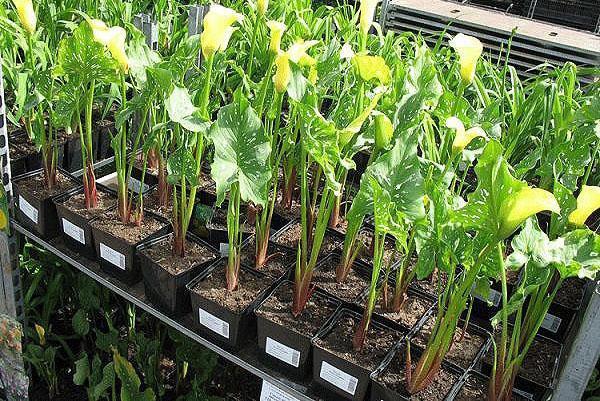Rules for planting and caring for calla lilies in the open field
 In our latitudes, two varieties of calla lilies perfectly coexist: tuberous and rhizome. If you follow the simple rules for growing calla lilies, planting and caring for it in the open field will lead to the appearance of beautiful flowers. An exotic plant will delight you for at least a month - that is how much it blooms calla.
In our latitudes, two varieties of calla lilies perfectly coexist: tuberous and rhizome. If you follow the simple rules for growing calla lilies, planting and caring for it in the open field will lead to the appearance of beautiful flowers. An exotic plant will delight you for at least a month - that is how much it blooms calla.
Preparing tubers for planting

Check the tubers ready for planting for rot. If they do appear, the surface of the tuber must be cleaned with a knife until healthy tissue appears. To firm up the tubers again, hold them in a damp cloth.
To protect calla lilies from fungal infections, you can treat the tubers with a fungicide (for example, Vitaros or Fundazol) right before planting.
It is advisable to plant calla lilies not immediately in open ground, but in pots with a prepared soil mixture - so they will survive planting less painfully. The soil should consist of a mixture of compost or humus with peat, garden soil and sand. Planting depth - about 2 cm from the surface of the tuber.
 Calla tolerates temperature extremes, so in spring the pots can be placed directly on the windowsill. Remember to water the tubers after planting, but it is advisable to do this carefully so as not to wash out the top layer of the soil. For the successful development of the plant, feeding is desirable mineral fertilizers once every 2 weeks.
Calla tolerates temperature extremes, so in spring the pots can be placed directly on the windowsill. Remember to water the tubers after planting, but it is advisable to do this carefully so as not to wash out the top layer of the soil. For the successful development of the plant, feeding is desirable mineral fertilizers once every 2 weeks.
 If you notice that the roots of the calla lilies are beginning to break through to the surface, add another 2 to 3 centimeters of soil into the pot.
If you notice that the roots of the calla lilies are beginning to break through to the surface, add another 2 to 3 centimeters of soil into the pot.
When and where to plant calla lilies on the site?
When to plant calla lilies outdoors? It is best to carry out planting work in the spring, as soon as the last frosts leave and the temperature stays above 15 degrees Celsius. Usually this is already the beginning or mid-May.
The planting site should be warm and sufficiently lit. A small partial shade is also suitable - in it, plants will be able to develop in almost the same way as in the sun. Make sure that there are no drafts and strong winds at the landing site of the calla lilies; an area with a mild microclimate is best suited.
It is better not to plant and care for calla lilies outdoors in direct sunlight. Flowers may suffer from this, and instead of a bright flower garden, you will just get lush vegetation.
It is better to choose the soil not neutral, but slightly acidic. Top dressing is applied before the flowering period; after the flowers appear, it is better to stop fertilizing the garden.
Features of planting garden calla lilies
 HIn order to plant and care for calla lilies in the open field, you need to follow some recommendations:
HIn order to plant and care for calla lilies in the open field, you need to follow some recommendations:
- You do not need to make holes too deep in order to plant flowers. It is better to lightly sprinkle rhizomes or tubers with a layer of earth so that they do not rot.
- Be careful not to damage the roots when you remove the calla from the pot. The roots are very fragile and do not grow back after breaking off.
- First, a root system is formed around the tuber, and only after that the calla sprouts. So if no more than a month has passed since landing, you shouldn't worry.
- Calla lilies are planted in open ground in the spring and taken care of only after the temperature stops dropping below 15 degrees.
- The best way to fertilize calla lilies is to remove the top layer of soil from the tubers and replace it with a nutritious mixture of peat, humus and a small amount of sand.
Calla lilies care
 If you properly care for young calla lilies, then they will begin to bloom within 1.5 months after planting on the site. Even if you plant calla lilies in open ground in Siberia, caring for them and a well-chosen place will help you get a beautiful flower garden.
If you properly care for young calla lilies, then they will begin to bloom within 1.5 months after planting on the site. Even if you plant calla lilies in open ground in Siberia, caring for them and a well-chosen place will help you get a beautiful flower garden.
One of the advantages of calla lilies is that you do not need to purchase any additional remedies against fungi and other diseases. These plants almost never get sick, as they can independently cope with pests.
Within 10-15 days after planting calla lilies in open ground, caring for it should consist in refusing to water. This is done in order not to allow the root system that has just begun to develop to rot. Even after the tubers get stronger, do not direct the stream of water directly at them when watering, it is enough to moisten the soil around the plant.
Fertilizing with mineral fertilizers can be carried out once a season, and this will be enough for the calla to bloom beautifully.
Storing calla tubers in the open field, wintering
 Caring for calla lilies from planting to the moment they change color is simple. However, as soon as autumn has arrived, the flowers need to be prepared for wintering. The tubers, along with the roots, are dug out before the first cold weather begins. This must be done especially carefully so that the root system is not damaged.
Caring for calla lilies from planting to the moment they change color is simple. However, as soon as autumn has arrived, the flowers need to be prepared for wintering. The tubers, along with the roots, are dug out before the first cold weather begins. This must be done especially carefully so that the root system is not damaged.
Leaving calla lilies outdoors in the Urals or Siberia for the winter is undesirable: it is highly likely that only a few plants will survive the frost. It is best to store the cleaned, washed and lightly dried tubers in a cool place at home, such as the vegetable section of the refrigerator. If, before the onset of cold weather, the calla leaves did not have time to fall off, they do not need to be torn off for about two more weeks so that the nutrients are transferred to the tubers.
Let's summarize:
- It is better to plant calla lilies not in direct sunlight, but in partial shade.
- Callas do not like too much watering and fertilization - feeding can be done only once a season.
- Calla lilies bloom well in slightly acidic soil with the addition of peat and compost.
- It is important not to damage the roots during transplanting and not to plant them too deep in the soil.
- Garden calla does not require additional protection against diseases and all kinds of pests. You can only treat the tubers with a fungicide just before planting.